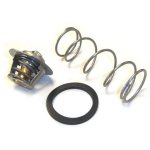- Jul 4, 2012
- 749
- Pool Size
- 21000
- Surface
- Vinyl
- Chlorine
- Salt Water Generator
- SWG Type
- CircuPool RJ-60 Plus
Over the weekend I was getting a high limit 2 fault after the heater was running for maybe a couple of hours. It was not a particularly hot day and water flow was about as strong as it gets (no blockages and freshly cleaned filter). After the first fault, I left the heater off for about 30 min with the pump running, then turned it back on. It fired up fine, ran for a few hours and then I got another high limit 2 fault.
So, after some researching I decided to pull the unitherm governor and inspect. It had some cottonwood on it, but not so much that would seem to interfere with its operation. I cleaned it off, took it in the house and put it in some hot water and it appeared to be operating correctly in that it was opening/closing with the temp changes. The gasket for the governor was pretty mangled however - could this be the source of my problems? Maybe it is letting in some outside temperatures that are causing the fault?
Any suggestions on next steps or is it best to replace the gasket and see if that solves things? (Open to suggestions on where to get the gasket as well.)
Thanks,
Paul
So, after some researching I decided to pull the unitherm governor and inspect. It had some cottonwood on it, but not so much that would seem to interfere with its operation. I cleaned it off, took it in the house and put it in some hot water and it appeared to be operating correctly in that it was opening/closing with the temp changes. The gasket for the governor was pretty mangled however - could this be the source of my problems? Maybe it is letting in some outside temperatures that are causing the fault?
Any suggestions on next steps or is it best to replace the gasket and see if that solves things? (Open to suggestions on where to get the gasket as well.)
Thanks,
Paul


